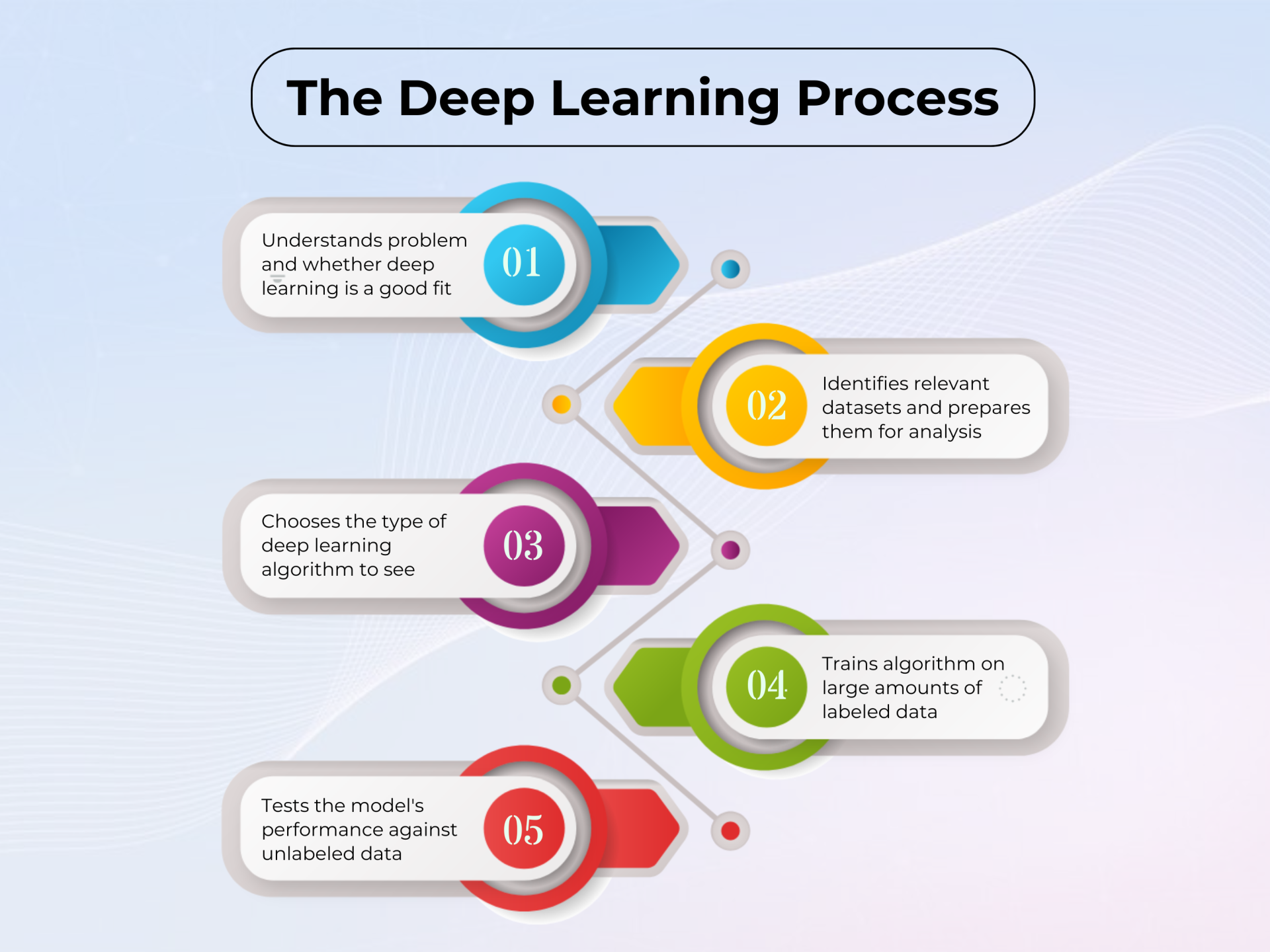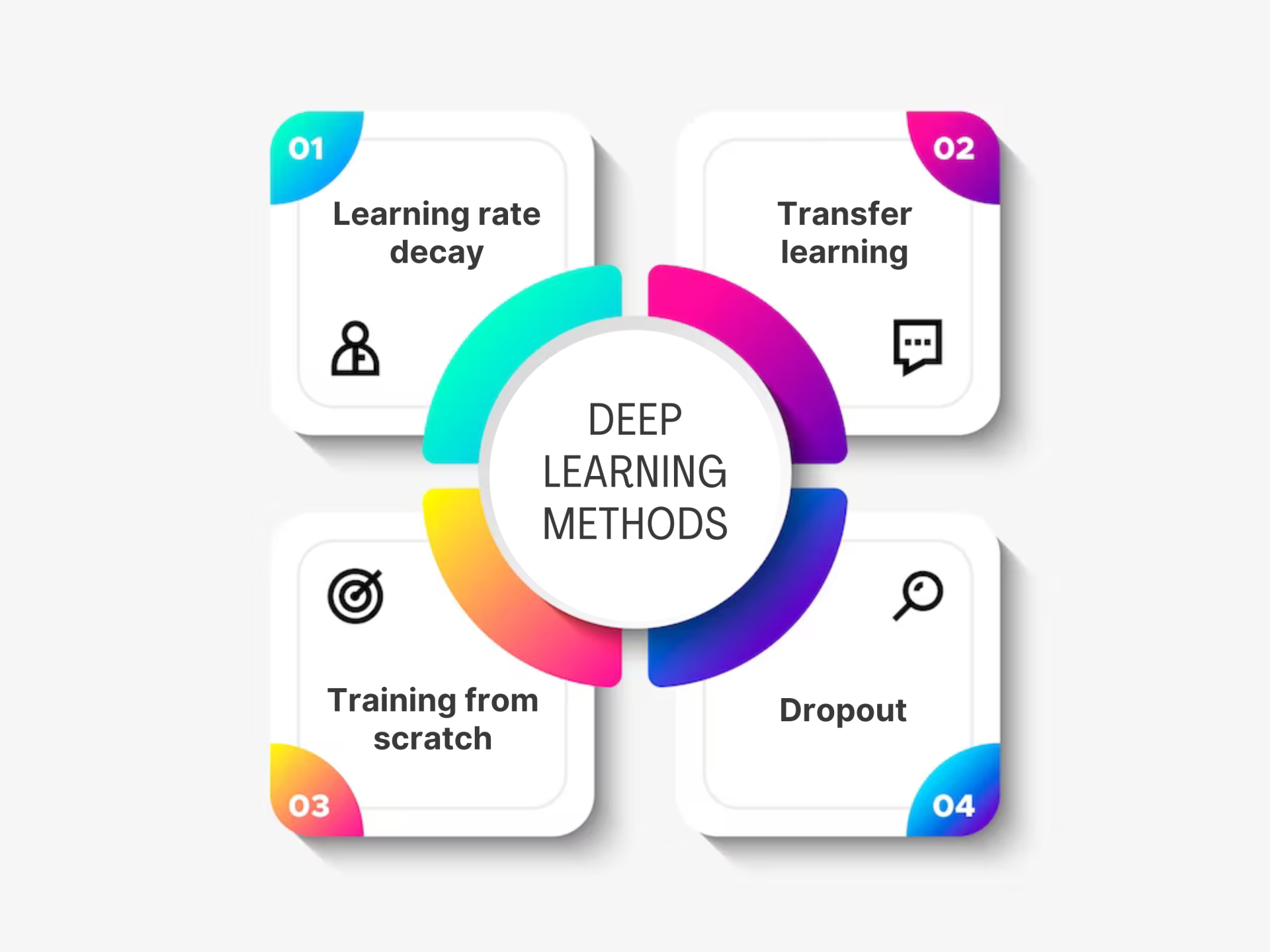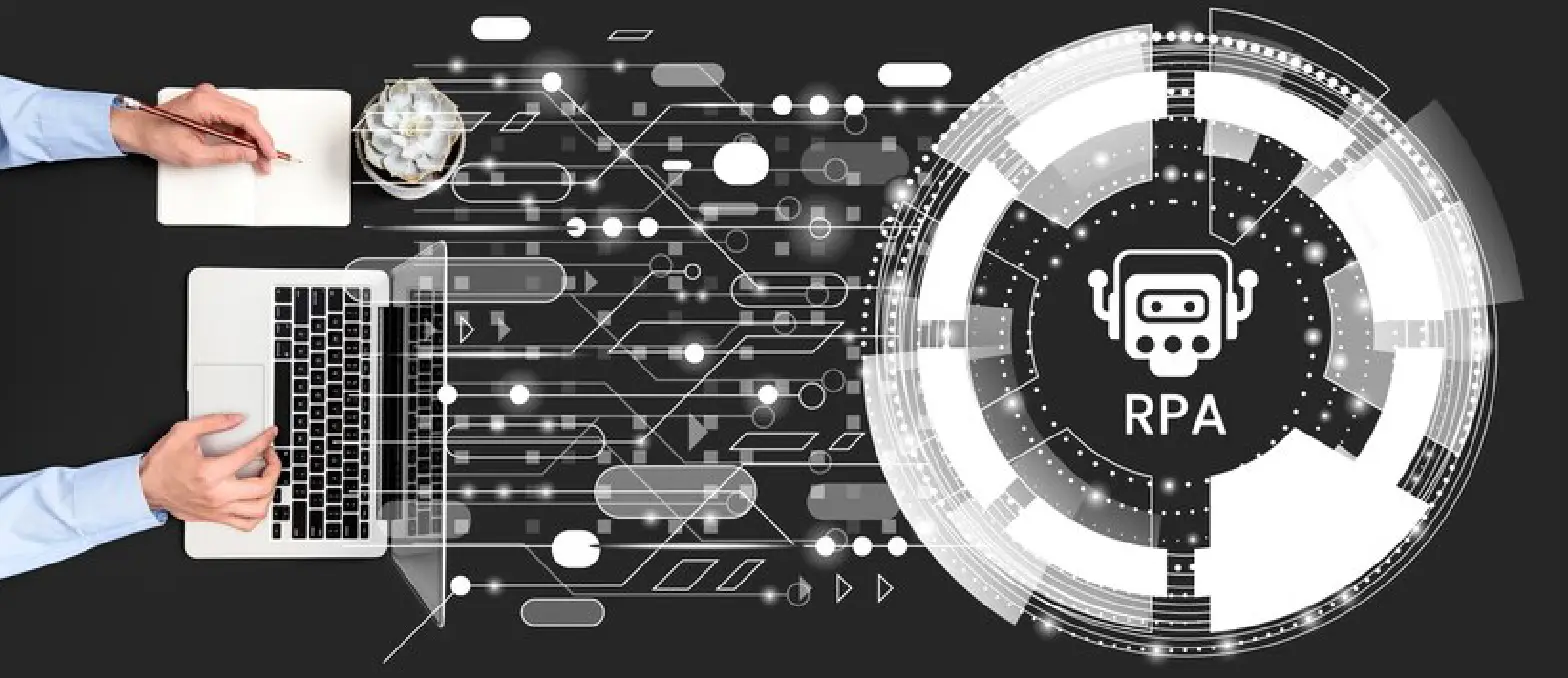Table of Contents
The use of Deep Learning (DL) has increased dramatically in today’s fast-paced corporate environment, indicating a significant shift in the way companies manage their operations and formulate strategy. The remarkable potential of deep learning to transform operational efficiency and decision-making is driving this upsurge. Deep learning can quickly analyze large data sets enabling businesses to derive meaningful insights. It can make data-driven decisions, and uncover patterns that were previously hidden. As a result, significant cost savings are achieved, and customer experiences are improved. Additionally, deep learning (DL) enables companies to create highly focused marketing campaigns, such as offering clients tailored recommendations, which increases customer engagement and loyalty.
The emergence of various deep learning development and consulting organizations is a major factor contributing to the increasing integration of deep learning technology. These organizations help their clients integrate AI into their business operations by offering them full-service advice. These businesses are essential collaborators for enterprises that are currently using machine learning, enabling them to grow and innovate while also enhancing their capabilities. They serve as dependable consultants, helping companies navigate the complexities of machine learning implementation with their data engineering knowledge, choosing the best algorithms, and creating unique models and solutions.
What is Deep Learning?
Deep learning is a branch of machine learning that teaches computers to learn by doing, just like people do. The market for machine learning is predicted to develop at a compound annual growth rate (CAGR of 38.8% from $21.17 billion) in 2022 to $209.91 billion by 2029. The market was valued at $15.44 billion in 2021 and is expected to continue growing due to the increased acceptance of technological advancements.
A better way to describe the technology would be as a set of algorithms that “learns in layers,”. Even if it is frequently thought of as a set of algorithms that “mimics the brain.” Through a process of layer learning, a computer can build a hierarchy of complex concepts from smaller ones. With deep learning, a model can learn to do tasks directly from text, audio, or visual input and can occasionally outperform humans in terms of accuracy. The core technology underlying many high-end advances, like hands-free speakers, voice control for tablets and smartphones, driverless automobiles, and many more, is deep learning. It is providing outcomes that were not achievable with conventional machine learning methods or even in the past.
Differences between Machine Learning & Deep Learning
| Aspect | Machine Learning | Deep Learning |
|---|---|---|
| Learning Method | Applies statistical algorithms | Utilizes artificial neural networks (ANNs) |
| Dataset Size | Works with smaller datasets | Requires larger volumes of data |
| Task Complexity | Better suited for low-label tasks | Better for complex tasks like image and natural language processing |
| Training Time | Generally shorter training time | Longer training time |
| Feature Extraction | Features are manually extracted from the data | Features are automatically learned from data |
| Interpretability | Results are easier to interpret | Results are often harder to interpret (black box) |
| Computing Requirements | Can work on CPU or requires less computing power | Requires high-performance computing with GPU |
Also Read in detail: Machine Learning vs. Deep Learning
What is the role of a Deep learning consulting company?
Deep learning consultancy helps firms increase their productivity and operational capabilities by applying complex artificial intelligence tactics. This solution enhances a company’s overall performance by optimizing AI technologies.
Deep Learning consulting company provides a range of services, which include:
- -Recognizing the business procedures of the corporation
- -Examining the objectives of the organization
- -Analyze data to obtain insightful information.
- -Identify appropriate technology
- -Adapt and customize strategies to meet the needs of the business.
Using the ML environment to increase the value of the business and better position it to handle the significant changes in the market and the intense competition is the main goal of machine learning consulting services. Using the best deep learning tools and algorithms, ML consulting firms assist businesses in creating and developing ML-rich products and solutions.
However, who wears the mask?
Your deep learning approach will benefit from the skills that deep learning consultancy brings to the table. Deep learning engineers create and implement deep learning models, whereas data scientists gather data and use data analytics to suggest future paths. Product managers are employed by deep learning consulting companies to oversee every step of the development process and guarantee the intended outcomes.
Connect With Our Deep Learning Consultants For Transforming Your Business
What does a deep learning consultant do?
Evaluating the demands of the business
The effectiveness of the implementation of a deep learning solution and the determination of its necessity depend on having a well-defined business aim. Misunderstanding business needs is a key cause of project failure, whether it be in the context of identifying which people to show advertisements to or forecasting an illness based on patient data. Not every issue calls for in-depth analysis. For example, basic rule-based techniques can be sufficient if the problem can be reduced to a collection of rules. It is up to your consultant to identify your business problem precisely so they can recommend the right solutions.
Gathering and Examining Data
Consultants can verify the data and proceed to model creation if they have enough data to create a deep-learning solution. Consultants can assist you in gathering, organizing, processing, and labeling data so that it is prepared for the model if you do not already have it. Model development consultants create a deep learning model that is suitable for the business issue you are facing. Thousands of experiments are conducted in this iterative process.
Full-cycle development of applications
It takes more software development and integration work to move a model into production. The majority of the time, ML models are contained in easily integrated APIs that may be used with any kind of application. It may be more difficult to establish the application than to construct the machine learning model. Working with outside developers is sometimes necessary for application development when integrating it with current enterprise systems. Creating an application would allow non-technical users to take advantage of the deep learning model that has been constructed.

How to Choose a Deep Learning Consulting Company
1. Appropriate background and knowledge
The firm’s knowledge and skills should be taken into account first and foremost. You wish to collaborate with a company that employs a group of knowledgeable and proficient machine learning specialists. The company ought to have a proven track record of finishing bespoke deep-learning software projects successfully. It is important to review the company’s case studies and portfolio. Check if they have worked on projects similar to yours in the past and have experience in your sector. Additionally, keep in mind that you want to engage with a company that can manage big datasets and expand its solutions to meet your growing business needs. It is therefore best to inquire about the company’s capacity to manage substantial data volumes and its plans for scaling its solutions.
2. Interaction and Teamwork
For each project, open communication and continuous support are necessities. Search for a company that can easily and clearly describe its methodology and procedure. Make sure the company is open to comments throughout the project and takes a collaborative approach. The company ought to be able to provide consistent assistance and good communication. Find out more about their project management team and talk to them about how they will communicate with you regarding the status of your project and any potential problems. To guarantee that your machine-learning solution continues to be successful, they should also provide continuing support.
3. Security and Privacy of Data
When interviewing with a machine learning company, this is undoubtedly an important issue to consider. Would you agree? It is imperative to take into account data security and privacy while collaborating with a machine learning company. Verify if the company values the security and confidentiality of your information. The company needs to adhere to all applicable data privacy laws and have a strong data protection policy. Additionally, be careful to enquire about the service provider’s data security policy and level of experience managing sensitive data.
4. Customization
Each company operates uniquely, with unique dynamics and definitions of machine learning and artificial intelligence. You could want to use chatbots, and automation to improve customer service. Or perhaps you have different expectations of those ML algorithms. To put it simply, choose a machine learning consulting company that offers specialized solutions made to fit your unique requirements. The company should be able to evaluate your data infrastructure, comprehend your business objectives, and create a customized solution that will satisfy your demands.
5. Price (and what you get in return)
One of the most important factors to consider when selecting a deep-learning consulting company is cost. Working with a company that offers competitive pricing is what you want. However, you shouldn’t skimp on the quality of the services you receive, whether it’s choosing the top machine learning models or offering reliable assistance. Seek out a company that provides value for money, meaning that the advantages of their solutions outweigh the costs due to the high caliber of their work.
6. Tools and technology
The set of tools and technologies will ultimately determine the final result of your approach. Make sure to brood and debate the available technology alternatives with the consultant during your conversation. Additionally, don’t hesitate to question them about the equipment they have previously utilized.
7. Schedules and Processes
Time is of the essence, so they say! Furthermore, it perfectly aligns with timetables, which is the next important consideration. It is necessary to convey the project schedules. Deadlines should be communicated clearly by top machine learning consulting companies with years of experience, a stellar track record, a ton of case studies, and competence. Above all, give them your full attention while they clarify the timelines. It’s that element where you can see how your culture and theirs complement each other.
Let Our Deep learning Experts Guide You to Elevate Your AI Strategy
Use cases of Deep Learning
Fraud Identification
A rising issue in the digital age is fraud. Customers filed 2.4 million fraud reports with the Federal Trade Commission in 2022. The two most prevalent types of fraud were identity theft and impostor schemes. Businesses such as Signifyd employ deep learning to identify abnormalities in user transactions to assist prevent fraud. These businesses utilize deep learning to gather information from multiple sources, such as the position of the device, the length of the stride, and credit card purchase trends, to build a personalized user profile. Using its Decision Intelligence and AI Express systems, Mastercard has used a similar strategy to enhance the accuracy of credit card fraud detection. Additionally, by lowering the number of fraudulent orders and chargebacks for merchants, Riskified is simplifying customer financing for businesses that depend on e-commerce.
Relationship Management with Customers
For revenue teams, customer relationship management systems are frequently called the “single source of truth.” They include correspondence, call logs, and notes about every client—past and present—as well as potential clients for the business. While combining that data has improved the customer experience for revenue teams, deep learning in CRM systems has opened the door to even more customer insights.
When a corporation gathers bits of data about potential consumers, deep learning can go through it all to identify patterns about why, when, and what retains them. This includes anticipating customer assistance requirements, extracting data from customer notes to facilitate trend identification, and predictive lead scoring, which assists businesses in identifying prospects with the highest likelihood of closing deals.
Computer Vision
Deep learning is ideal for training vision-based AI systems because it attempts to replicate how the human mind processes information and looks for patterns. These platforms can recognize items such as faces, firearms, and airplanes by ingesting tagged photo sets and using deep-learning models.
Image recognition has a wide range of applications. Neurala completes industrial quality inspections using an algorithm it refers to as Lifelong-DNN. Others, such as ZeroEyes, employ deep learning to find weapons in public areas like government buildings and schools. In an attempt to stop shootings, the technology is intended to notify authorities when a gun is discovered. Lastly, businesses like Motional use AI technology to improve their autonomous car LiDAR, radar, and camera systems.
Farming
Food production will continue to be largely derived from agriculture in the years to come, therefore researchers have discovered ways to use deep learning and artificial intelligence to streamline the process. A Forbes report from 2021 stated that by 2026, the agriculture sector anticipates spending $4 billion on AI technologies. Farmers have previously adapted AI for various purposes, using it to anticipate crop harvests, detect intruding wild animals, and power self-driving gear.
Blue River Technology has used robots, computer vision, and machine learning to investigate the potential of self-driven agricultural goods. Positive outcomes have led to intelligent machines, such as a lettuce bot that can identify weeds and target them with a herbicide sprayer while sparing other plants. Furthermore, businesses like Taranis utilize a combination of deep learning and computer vision to monitor fields and stop crop loss from weeds, insects, and other factors.
Artificial Voice
Deep learning is essential for producing human-like speech reproduction and voice-to-text translation. Deep learning models provide voice recognition and text-to-audio translation for apps like Siri and Google Voice Search. Next, there is DeepMind’s WaveNet model, which uses neural networks to recognize syllable patterns, inflection points, and other features in the text. This allows businesses such as Google to teach their virtual assistants to sound more like real people. Furthermore, it was useful in Mozilla’s 2017 RRNoise Project to detect and reduce background noise in audio files, giving users access to crisper audio.
Natural Language Processing
The global natural language processing market is expected to grow from $26.42 billion in 2022 to $161.81 billion by 2029. With the advent of natural language processing technology, robots can now comprehend communications and extrapolate meaning from them. Nevertheless, the procedure may be a little oversimplified, not taking into consideration how words interact to alter the meaning or intent of a statement.
Natural language computers can now recognize more intricate patterns in phrases and offer a more accurate interpretation thanks to deep learning. Businesses such as Gamalon leverage deep learning to power chatbots that can reply to a higher volume of messages with greater accuracy. Other businesses, such as Strong, employ it in their natural language processing (NLP) applications to assist users with sentiment analysis, text translation, and text categorization for data mining from a collection of communications. In addition to applying grammatical rules and patterns, Grammarly leverages deep learning to assist users in recognizing writing errors and determining the tone of their messages.
Refining Data
In the case of gathering massive volumes of unprocessed data, it is hard for the data scientist to find trends or to do much with the information. Proper handling of data is necessary. Deep learning algorithms are useful in such cases. The raw data is accessible with the use of deep learning algorithms. A cloud-based supercomputer is used by organizations such as Descartes Labs for data refinement. Sifting through vast amounts of unprocessed data can be helpful for food security, illness prevention, catastrophe mitigation, and satellite images.
Digital Assistants
As virtual assistants become more commonplace, the line separating humans and technology becomes less and less distinct. These AI-driven tools process commands by combining machine learning, deep learning, and AI approaches. Two well-known examples are Google’s Assistant and Apple’s Siri, which can both function on laptops, speakers, TVs, and other gadgets. Shortly, people should anticipate seeing more chatbots and virtual assistants since the market can grow significantly until 2030.
Driverless Automobiles
Even though completely autonomous vehicles are still some ways off, deep learning has been important in advancing the field. It enables self-driving cars to consider your destination, anticipate the actions of surrounding barriers, and plan a secure route to bring you there.
For example, Zoox has improved its completely autonomous robot taxi vehicles’ decision-making capabilities by using AI technology to help them learn from some of the most difficult driving conditions. Other deep learning-powered self-driving car firms include Waymo, a Google company, and DeepScale, owned by Tesla.

Benefits of deep learning
You might wonder why so many massive IT companies are gradually implementing deep learning. We must examine the benefits of employing an AI & deep learning strategy to get the rationale. These are the top five benefits of utilizing this technology.
Utilizing unstructured data to the fullest
A significant portion of an organization’s data, according to Gartner research, is unstructured because it is mostly stored in various formats, such as texts and images. Unstructured data is hard for most machine learning algorithms to understand, thus it stays underutilized. This is precisely the situation where deep learning shines. The training of deep learning algorithms can be with a variety of data types. They can still yield insights that are pertinent to the training goal. For example, you can anticipate the future stock values of a certain company by using deep learning algorithms to find any relationships that may exist between industry data, social media activity, and more.
No longer requiring feature engineering
Feature engineering is an essential task in machine learning since it increases accuracy. However, it occasionally calls for domain expertise on a particular issue. The capacity of the deep learning approach to carry out feature engineering on its own is one of its greatest advantages. This method involves an algorithm that without explicit instruction, searches the data for qualities that correlate, combines them, and speeds up learning. This capability saves a great deal of labor for data scientists.
Capacity to produce excellent outcomes
Humans occasionally make thoughtless errors and experience hunger and fatigue. This isn’t the case with neural networks, though. After being appropriately taught, a deep learning model can complete thousands of repetitive, ordinary tasks much faster than a human could after training. Furthermore, unless the training data comprises raw data that isn’t representative of the issue you’re attempting to solve, the quality of the job never decreases.
Reduction of superfluous expenses
Recalls are quite costly; in certain industries, an organization’s direct expenditures from a recall may reach millions of dollars. Deep learning can be used to identify subjective flaws that are challenging to train, such as small mistakes in product labeling. Additionally, problems that would be challenging to detect otherwise can be identified using deep learning models. Deep learning can acquire useful features to make the inspections robust and can account for differences in consistent photos that become difficult for various reasons.
No longer requiring data labeling
Data labeling is a labor-intensive and costly task. The deep learning approach eliminates the necessity for well-labeled data because the algorithms are capable of learning in the absence of guidelines. This kind of learning outperforms other machine learning techniques by a wide margin.
Connection between generative AI and deep learning?
For the first time, ChatGPT allowed the general public to see and interact with AI. Transformer networks are a type of deep learning technique useful to train ChatGPT and other language models similar to it to produce content in response to cues. Transformer networks enable modern AI technologies to anticipate by assigning varying weights to distinct segments of the input sequence. Compared to typical machine and deep learning models, transformer networks, which consist of encoder and decoder layers, allow gen AI models to learn links and dependencies between words in a more flexible fashion. This is because transformer networks are trained on vast portions of the internet (like all traffic footage ever captured and uploaded) as opposed to a particular piece of data (like specific stop sign photos, for example).
As will be covered in more detail below, foundation models trained on transformer network architecture—such as Google’s BERT or OpenAI’s ChatGPT—can apply their knowledge from one task to a broader range of tasks, such as content generation. You might now instruct a model to record a video of a car running a stop sign.
Although foundation models are capable of producing material, they have no concept of good and wrong or even what constitutes acceptable behavior in society. When ChatGPT was initially developed, it needed a lot of human input to become intelligent. To help refine the system, OpenAI hired a sizable workforce from all around the world to clean and classify data sets as well as identify and flag harmful information for removal. The groundbreaking nature of ChatGPT can be attributed in large part to this human input.
Conclusion
Deep learning applications help companies across a variety of industries create new products, boost sales, and cut expenses. Nevertheless, creating and executing an effective deep-learning application has a unique set of difficulties. Deep learning consultants are instrumental in helping companies navigate challenges and reduce the risk of misallocating resources to unfruitful projects. As one of the most powerful machine learning techniques at our disposal, deep learning boasts a wide array of uses. Its capabilities extend to automated forecasting, image recognition, and understanding of human language. The majority of machine learning companies can assist you in integrating deep learning into your operational procedures. However, because creating deep learning apps presents unique obstacles, seeking advisory services from businesses that specialize in deep learning applications can yield better outcomes.
FAQs
Who is a deep learning consultant?
An individual with high experience in artificial intelligence is an AI consultant. AI consultant with a focus on advising and executing deep learning approaches and solutions for organizations. That too across multiple industries is known as a deep learning consultant. Drawing inspiration from the intricate neural networks of the human brain, deep learning emerges as a specialized subset within the broader realm of machine learning.
Which three categories of deep learning exist?
The best deep learning algorithms can assist both novices and experts in deciphering challenging deep learning problems. These are:
- Convolutional neural networks, also known as CNNs
- Long short-term memory networks, or LSTMs
- Recurrent neural networks, also known as RNNs
What is deep learning consulting?
With relatively little human guidance, deep learning enables us to create computer systems that can analyze complicated material, including text, images, voice, and video. There are a plethora of fascinating commercial applications for this, and most businesses have yet to begin utilizing deep learning’s potential.
What is the purpose of deep learning?
Artificial intelligence (AI) deep learning trains machines to process information. This is similar to training the human brain. To generate precise insights and forecasts, deep learning models can identify intricate patterns in images, text, sounds, and other types of data.
Which artificial intelligence makes use of deep learning?
Online service providers’ virtual assistants, such as Alexa, Siri, and Cortana, use deep learning to comprehend human speech and language during interactions. Similar to this, deep learning systems can translate between languages automatically.
Why is it called deep learning?
The subset of machine learning techniques based on neural networks and representation learning is called deep learning. The use of numerous layers in the network is indicated by the phrase “deep“.






